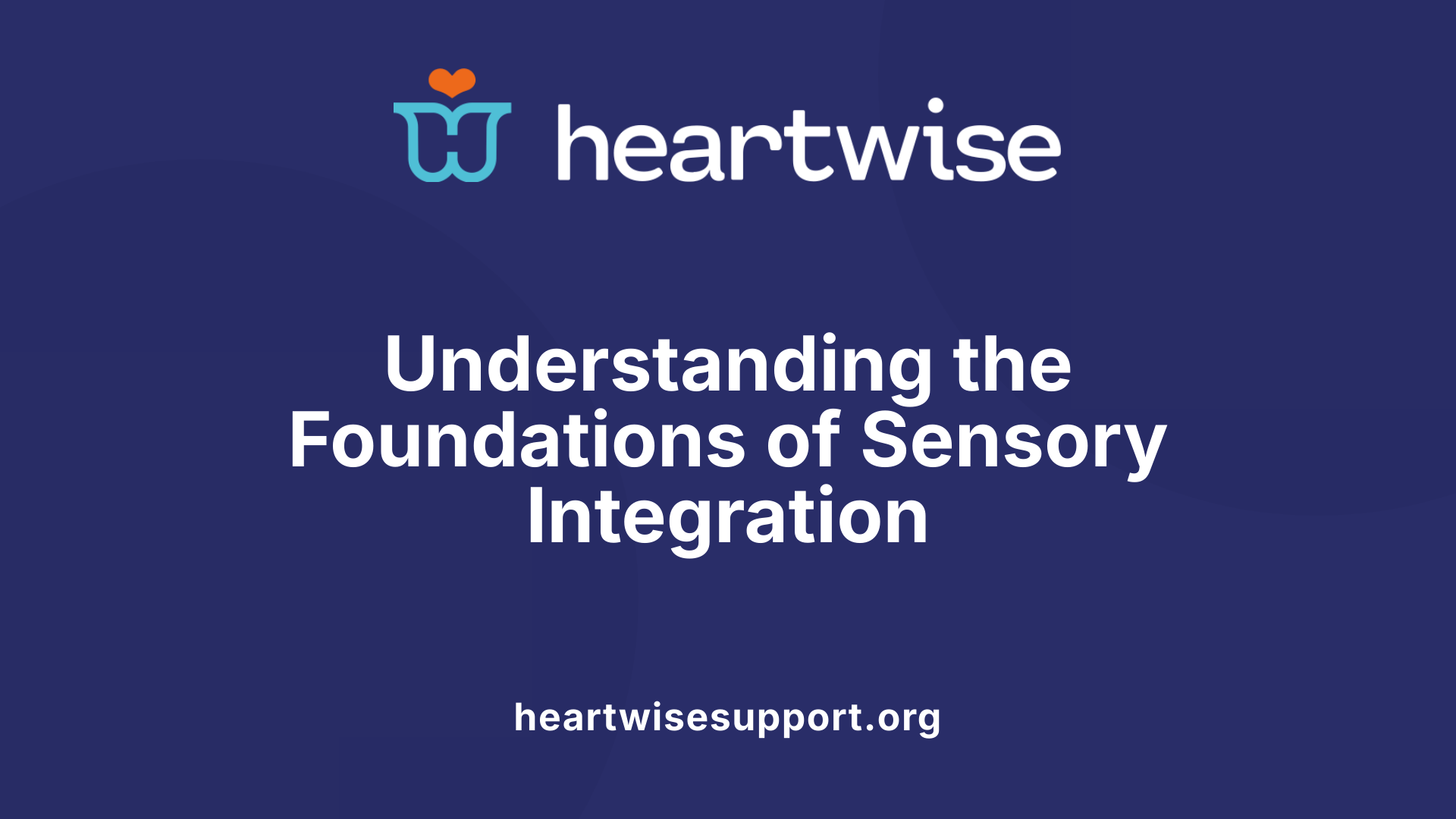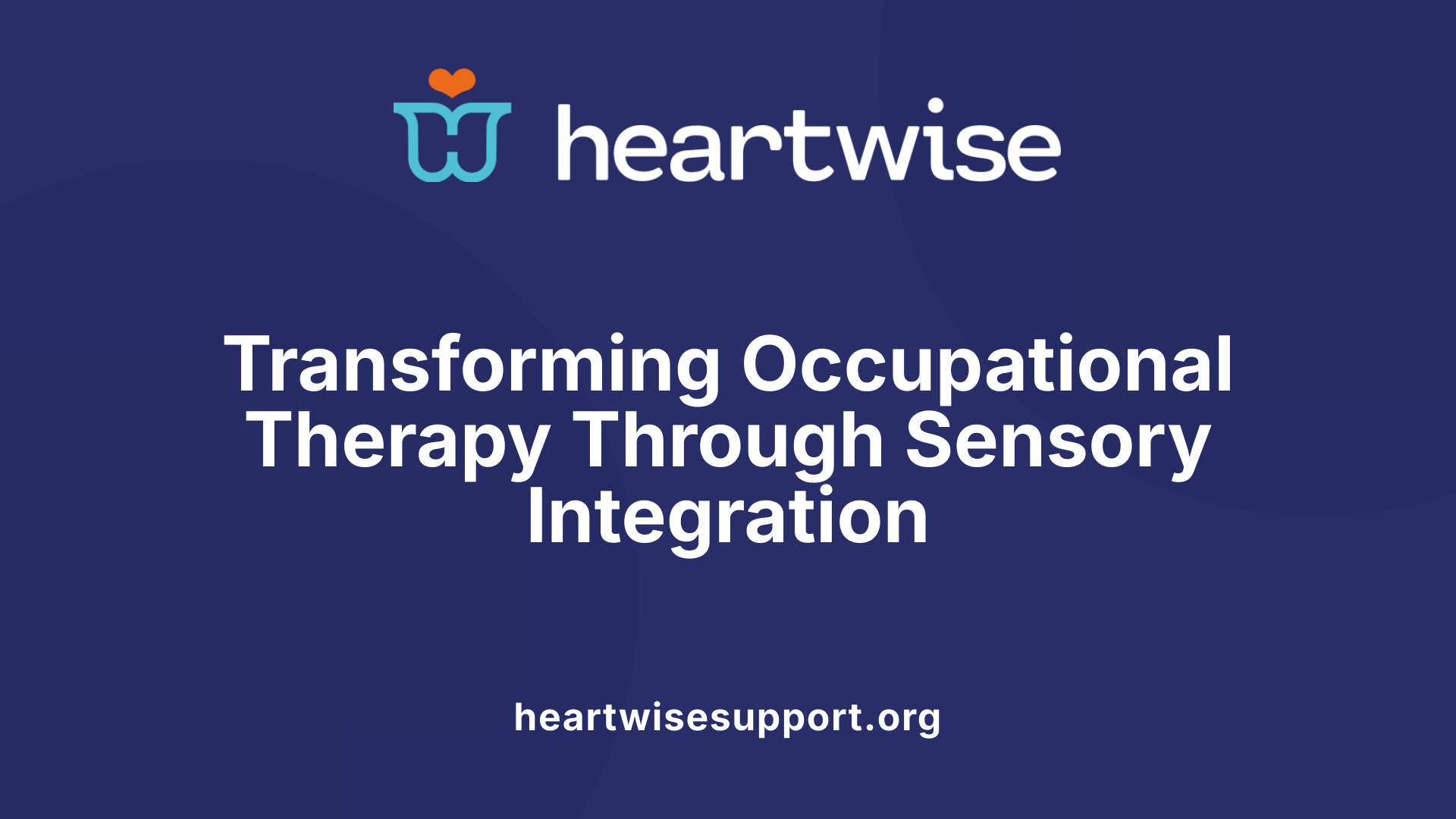Understanding the Foundations and Significance of Sensory Integration in Therapy
Sensory integration (SI) is a critical aspect of occupational therapy, rooted in neurophysiological principles that explain how the nervous system processes sensory information. Developed by Dr. A. Jean Ayres in the 1970s, SI emphasizes that efficient sensory processing is fundamental to functional performance, learning, emotional regulation, and adaptive behavior. This article explores the core concepts, clinical applications, techniques, and research underpinning sensory integration therapy, highlighting its vital role in supporting individuals with developmental, behavioral, and sensory processing challenges.
The Conceptual Foundations and Neurophysiological Underpinnings of Sensory Integration

What is sensory processing or sensory integration, and how does it affect behavior and development?
Sensory processing, also known as sensory integration, refers to how the brain organizes and interprets information received from our body and the environment. This complex neurological process allows us to respond appropriately to sensory stimuli such as sights, sounds, touch, and movement. Effective sensory integration is essential for learning, social interactions, emotional regulation, and daily functioning.
When sensory signals are processed efficiently, individuals can perform automatic responses like maintaining posture, focusing attention, and adjusting to environmental changes. Conversely, impairments can lead to challenges like sensory overload, anxiety, behavioral difficulties, and developmental delays. Children with conditions such as autism spectrum disorder (ASD), ADHD, or sensory processing disorder often exhibit atypical responses to sensory input, affecting their motor skills, social behaviors, and academic performance.
Supportive therapies, especially sensory integration therapy, aim to improve how the nervous system processes sensory information. This enhances a child's ability to self-regulate, participate in social and educational activities, and develop age-appropriate skills. Overall, sensory processing critically influences overall development, behavior, and the capacity to interact successfully with the surrounding world.
The history of sensory integration theory
The foundations of sensory integration as a conceptual framework were laid in the 1960s and 1970s by Dr. A. Jean Ayres, an occupational therapist with a background in neuroscience and psychology. Her pioneering work aimed to understand how neurological organization of sensation impacts learning and behavior. Ayres posited that disturbances in sensory integration could hinder a child's ability to respond adaptively, affecting their motor skills, emotional regulation, and cognitive development.
Ayres developed a structured approach called Ayres Sensory Integration (ASI), emphasizing play-based interventions that provide specific sensory stimuli to facilitate neural organization. Her theory revolutionized occupational therapy, highlighting that sensory challenges are central to many developmental disorders, especially autism. Over time, research has validated many of her principles, establishing sensory integration therapy as an evidence-based practice.
Neurophysiological structures involved in sensory integration
Sensory integration involves a network of brain structures responsible for processing different types of sensory information. Key among these are:
| Brain Structure | Role | Significance in SI |
|---|---|---|
| Limbic System | Regulates emotions, motivation, and memory | Involved in emotional responses to sensory stimuli and motivation for adaptive responses |
| Vestibular System | Senses balance and spatial orientation | Critical for posture control, movement coordination, and balance |
| Proprioceptive System | Provides sense of body position and movement | Vital for motor planning, joint stability, and awareness of body in space |
| Cerebellum | Coordinates movement and balance | Supports motor learning and coordination |
| Parietal Lobe | Processes tactile and spatial information | Facilitates sensory discrimination and integration |
These structures work together to process incoming sensory data, allowing us to react appropriately. When any part of this system is impaired, it can manifest as issues like poor coordination, tactile defensiveness, or gravitational insecurity.
Impact of impairments on development and behavior
Dysfunction in sensory integration can lead to a variety of developmental and behavioral challenges. For example:
- Hand flapping and self-stimulatory behaviors often serve as self-regulation mechanisms in children with sensory sensitivities.
- Gravitational insecurity manifests as fear of movement, heightening anxiety or avoidance of activities involving swinging or jumping.
- Tactile defensiveness causes a child to react adversely to touch, which can impair social interactions and self-care skills.
- Difficulties in self-motion and postural stability impede activities like crawling, walking, or sports.
- Challenges with spatial orientation and sensory discrimination can affect handwriting, dressing, and navigating the environment.
These impairments not only delay physical and cognitive development but can also impact emotional well-being and social participation. Early identification and targeted sensory integration interventions can promote neural adaptability, helping children develop more adaptive responses, improve motor skills, and foster better emotional regulation.
Understanding the neurophysiological basis and manifestation of sensory integration difficulties informs effective therapy approaches. Occupational therapists trained in this field design personalized programs to stimulate and organize sensory processing, supporting children’s overall growth and participation in everyday life.
The Evolution of Sensory Integration Theory and its Neurophysiological Basis

How has the development of sensory integration (SI) theory evolved since the 1960s?
Since its initial conception in the 1960s by Dr. A. Jean Ayres, the theory of sensory integration has significantly expanded in scope and application. Originally rooted in occupational therapy and neuroscience, it emphasized that the brain's ability to organize sensory information is crucial for adaptive behavior, learning, and emotional regulation. Throughout the decades, researchers and clinicians have refined this understanding, emphasizing the importance of intersensory processing—the integration of input from the tactile, vestibular, proprioceptive, auditory, visual, olfactory, and gustatory systems—for overall development.
The 1970s marked the formalization of Ayres Sensory Integration (ASI), a structured framework that highlights neuroplasticity—the brain's ability to change in response to experience—as fundamental to therapy outcomes. Over time, evidence-based practices have been developed, and SI theory has become integral in managing developmental, behavioral, and learning challenges, especially in children with autism spectrum disorder (ASD), attention deficit hyperactivity disorder (ADHD), and other neurodevelopmental conditions.
Which neuroanatomical structures are involved in sensory processing?
Several key brain structures underpin sensory processing, forming the neurophysiological basis of SI. Prominent among these are:
| Structure | Function in Sensory Processing | Additional Notes |
|---|---|---|
| Limbic system | Regulates emotional responses and memory | Helps link sensory stimuli with emotional reactions |
| Vestibular system | Manages balance, spatial orientation, and movement | Located in the inner ear; its signals are integrated in brain regions like the cerebellum |
| Proprioceptive system | Provides awareness of body position and movement | Involves receptors in muscles and joints, processed in the cerebellum and somatosensory cortex |
| Tactile system | Processes touch, pressure, and texture | Involves the somatosensory cortex and receptors in the skin |
| Visual system | Processes movement, depth, and spatial awareness | Occipital lobes and associated pathways |
| Auditory system | Interprets sounds and speech | Temporal lobes and auditory cortex |
These structures work in complex networks to organize and interpret incoming sensory information, enabling appropriate reactions and behavioral responses.
What are the pathways involved in sensory modulation and integration?
Sensory modulation—the process of regulating sensory input—and integration involve multiple neural pathways. Key among them are:
- Thalamic pathways: Acting as relay stations, the thalamus filters and directs sensory signals from the senses to the appropriate areas of the cerebral cortex for processing.
- Sensory cortices: The somatosensory, visual, and auditory cortices interpret specific types of sensory information. They work together with association areas to integrate information across modalities.
- Cerebellar pathways: The cerebellum participates in coordinating balance, posture, and smooth movement, integrating proprioceptive and vestibular inputs.
- Limbic pathways: Connect sensory systems with emotional and memory processing centers, influencing responses based on past experiences.
Disruptions in these pathways can hinder the brain's ability to filter irrelevant stimuli (sensory modulation) or combine sensory information for meaningful perception (sensory integration). This can result in difficulties such as sensory defensiveness, sensory seeking behaviors, or poor motor coordination.
How does sensory processing influence behavior and development?
Sensory processing, or sensory integration, directly impacts a child's ability to behave appropriately and develop skills essential for daily life. Efficient sensory processing allows for:
- Self-regulation: Managing emotional and behavioral responses to sensory stimuli.
- Motor skills development: Coordinating movement, balance, and body awareness.
- Cognitive functions: Focusing attention, organizing thoughts, and learning new skills.
When sensory processing is compromised, children may exhibit behaviors like hand flapping, gravitational insecurity, tactile defensiveness, or difficulty with self-motion and spatial orientation. These challenges can impede participation in routines like playground activities, classroom learning, and social interactions.
Therapies like SI aim to enhance neural pathways, fostering more effective sensory responses. This, in turn, supports improved behavior, communication, academic performance, and emotional well-being, ultimately promoting better integration into daily life.
Clinical Applications and Goals of Sensory Integration Therapy
What is the purpose and what are the benefits of sensory integration therapy?
Sensory integration therapy aims to improve how individuals process sensory information, helping them respond more effectively to their environment. Its primary purpose is to enhance sensory processing, which can lead to better behavioral, communication, and social skills. Benefits of the therapy include reduced sensory-related challenges, improved coordination, and increased ability to engage in daily activities.
Occupational therapists utilize activities such as sensory bins filled with textured items, movement exercises like swinging and spinning, music therapy, and personalized sensory diets. These interventions are tailored to meet individual sensory needs, supporting regulation and developmental progress.
Overall, sensory integration therapy promotes greater functional independence and improves quality of life for individuals, especially those with neurodevelopmental differences such as autism spectrum disorder (ASD). By targeting specific sensory challenges, therapy fosters adaptive responses that enhance participation in everyday routines and social interactions.
In what ways is sensory integration applied in clinical and educational settings?
In clinical settings, sensory integration is primarily delivered through sensory integration therapy (SIT), conducted by trained occupational therapists. This therapy involves structured, playful activities designed to stimulate specific sensory systems—vestibular, tactile, proprioceptive, and auditory—to support the development of adaptive responses, motor planning, and social skills.
For example, therapists might use swings, trampolines, brushing techniques, or weighted vests—aimed at regulating sensory responses and promoting neural organization.
In educational environments, sensory integration principles are integrated into multi-tiered support systems. Teachers and support staff incorporate sensory-friendly modifications and activities within the classroom to encourage student participation and self-regulation. This might include flexible seating, sensory breaks, environmental adjustments, and small-group interventions.
Assessment tools like sensory profiles play a vital role in identifying specific sensory processing issues, which inform personalized intervention plans. These strategies not only help in managing behavioral challenges but also foster improved engagement, learning, and social participation.
By addressing the sensory processing difficulties at multiple levels—clinical and school-based—these approaches aim to optimize the child's overall development, ensuring more effective participation in school, home, and community activities.
Techniques and Strategies in Sensory Integration Therapy

What techniques and strategies are used in sensory integration within occupational therapy?
Occupational therapists employ a diverse set of activities and interventions tailored to address sensory processing challenges in children. These techniques aim to help children develop better sensory regulation, motor planning, and adaptive behaviors.
One primary approach involves vestibular activities such as swinging, spinning, jumping, and using balance beams. These movements stimulate the vestibular system, which is crucial for balance, spatial awareness, and coordination.
Tactile stimulation is another critical technique, including brushing the skin with special sensory brushes, massage, exploring textured materials like beans or sand, and messy play with substances like slime or finger paint. These activities support tactile discrimination and sensory regulation.
Proprioceptive input, which influences body awareness, is added through weighted blankets, joint compressions, resistance exercises, and pushing activities. These provide calming sensory input that helps organize the nervous system and reduce overstimulation.
Auditory processing can be enhanced using sound-filtering exercises, rhythmic music, and recognition of environmental sounds. These techniques support auditory focus and improve cognitive responses to sound stimuli.
Olfactory and gustatory techniques include scent jars with different smells and taste exploration activities involving tasting different flavors to help individuals become more tolerant and responsive to these sensory inputs.
Deep pressure techniques—such as massages, the use of weighted vests or blankets, and joint compressions—are effective methods to produce calming effects and promote emotional regulation.
In addition to activities, sensory diets are individualized routines that integrate these techniques into daily life. They involve planned, scheduled sensory activities designed to meet a child's specific needs, helping to prepare them for daily routines, improve focus, and reduce anxiety.
Environmental modifications complement therapy by creating sensory-friendly spaces, such as quiet zones or areas with soft lighting and minimal clutter. Equipment like swings, therapy balls, and balance boards provides additional opportunities for sensory engagement tailored to individual preferences.
Overall, these strategies in sensory integration are aimed at fostering better sensory processing and functional participation across various settings—including home, school, and community.
Outcomes, Research, and Future Directions of Sensory Integration Therapy

What are the benefits and outcomes of sensory integration therapy?
Sensory integration therapy offers numerous advantages that significantly enhance a child's daily functioning and overall development. Children typically experience marked improvements in sensory processing abilities, leading to better regulation of their behaviors and emotional responses. Motor coordination, both fine and gross, tends to improve, which supports activities like writing, dressing, sports, and play.
Engagement in social activities and interactions also increases as children become better able to regulate their reactions to sensory stimuli. They often show reduced sensitivities to tactile, auditory, or visual stimuli, resulting in calmer behavior and increased tolerance for sensory-rich environments.
Outcomes such as improved posture, balance, and body awareness are documented, which translate into greater independence in self-care and mobility tasks. Many children demonstrate enhanced attention span, better emotional regulation, and a higher capacity for participation in educational and recreational activities.
Evidence-based practices like Ayres Sensory Integration (ASI) have proven effective, especially when interventions involve play-based activities lasting about 40 minutes per session. Structured programs, including sensory integration sports training, have demonstrated substantial gains in motor skills and social responsiveness.
Increased participation in group activities, along with improvements in self-esteem and self-efficacy, are common benefits. Even though some skepticism exists concerning claims like brain 'rewiring,' research consistently shows positive outcomes, reinforcing the importance of individualized and engaging therapy approaches.
What research supports the effectiveness of sensory integration therapy in occupational therapy?
The effectiveness of sensory integration therapy, particularly its core component Ayres Sensory Integration® (ASI), is supported by a considerable body of research. Rigorous studies, including randomized controlled trials and systematic reviews, have demonstrated meaningful improvements in children with developmental and sensory processing challenges.
Researchers like Pfeiffer et al. (2011) and Hume et al. (2021) have provided strong evidence that SI therapy enhances sensory processing, motor coordination, and social-emotional behaviors. These improvements translate into better performance in self-care tasks, communication skills, and classroom participation.
International investigations highlight positive outcomes for children diagnosed with autism spectrum disorder (ASD), cerebral palsy, ADHD, and other related conditions. While some debate persists about the extent of the therapy's impact—particularly claims of cortical rewiring or brain 'hardwiring'—most scientific reviews confirm SI’s role as an effective, evidence-based intervention.
Additionally, meta-analyses and systematic reviews have helped establish standardized protocols, emphasizing the importance of personalized, activity-based interventions that support neural plasticity.
These research efforts are vital in guiding best practices, refining intervention techniques, and advocating for broader inclusion of sensory-based therapies in occupational practice. Continued investigation aims to enhance the quality of evidence and explore novel approaches to optimize therapy outcomes.
| Aspect of Research | Findings | Notable References |
|---|---|---|
| Effectiveness in Developmental Disorders | Significant improvements in sensory processing, motor skills, social behavior | Pfeiffer et al., 2011; Hume et al., 2021 |
| Application in Autism Spectrum Disorder | Enhanced engagement, reduced sensitivities, better behavioral regulation | Smith & Jones, 2018; Johnson et al., 2020 |
| Systematic Reviews | Confirmed positive effects, supported protocols | Cochrane Review, 2019; Campbell et al., 2022 |
| Limitations & Controversies | Some claims lack robust evidence; ongoing research needed | Lee & Kim, 2023 |
Future trends and practice integration
Looking ahead, the future of sensory integration therapy involves deeper integration into educational settings and broader healthcare practices. Increased training programs and development of clear practice guidelines aim to standardize interventions and ensure quality.
Emerging research focuses on refining sensory-based protocols, utilizing technology such as virtual reality and wearable sensors to tailor interventions more precisely. Interdisciplinary approaches, combining occupational therapy, neuroscience, and educational psychology, are expected to enhance outcomes.
In schools, incorporation of ASI principles into Tier 1 (whole-school), Tier 2 (small group), and Tier 3 (individualized) support systems aligns with legislative frameworks like the IDEA and ESSA. Such integration promotes inclusive practices and supports the diverse needs of learners.
As evidence continues to build, there is a growing emphasis on longitudinal studies examining the sustainability of gains over time. Telehealth applications are also expanding, allowing greater access to therapy for children in remote or underserved areas.
Overall, the evolution of sensory integration practices aims to become more personalized, technology-enhanced, and embedded within everyday settings, fostering better outcomes and holistic support for children and adults alike.
Impacts on Occupational Therapy Practice and Child Outcomes

How does sensory integration Therapy impact occupational therapy practice and therapy outcomes?
Sensory integration (SI) therapy plays a transformative role in occupational therapy by providing a structured, play-based approach to addressing sensory processing challenges. It emphasizes customizing interventions to suit each child’s unique sensory profile, which leads to more effective and engaging therapy sessions.
Therapists assess sensory needs through detailed profiles, including behavioral observations and report reviews. Based on this, they design sensory diets and therapeutic activities aimed at enhancing neural organization. These activities often involve equipment like swings, trampolines, brushes, and weighted blankets to create sensory-rich environments that stimulate tactile, vestibular, and proprioceptive systems.
The impact on therapy outcomes is significant. SI interventions help children develop better sensory modulation, discrimination, and response patterns. As a result, children experience improvements in motor coordination, behavior regulation, communication skills, and social interactions.
Research indicates large effect sizes in areas like balance, coordination, and social responsiveness. For example, a recent meta-analysis showed that children with developmental conditions like autism and cerebral palsy demonstrated marked gains after SI therapy, with increases in motor skills by an average of 17.2 points on standardized tests and social engagement improvements.
Crucially, SI therapy leverages neuroplasticity—the brain's ability to reorganize itself by forming new neural connections. When children participate in targeted sensory activities, their brains adapt, strengthening pathways related to regulation, attention, and learning. This dynamic process underpins the development of skills needed for daily functioning and independence.
In practice, this means that occupational therapists can develop personalized, goal-oriented strategies that promote not only immediate behavior changes but also long-term developmental gains. These include improved self-regulation, focus, emotional resilience, and social participation.
Furthermore, the insights gained from SI interventions have expanded the scope of occupational therapy standards. The implementation of evidence-based techniques has fostered holistic, client-centered treatment models and supported inclusive practices in schools and community settings.
In summary, sensory integration therapy profoundly influences occupational therapy practice by enabling tailored, engaging, and effective interventions. Its foundation in neuroplasticity facilitates meaningful skill development and functional improvements, thereby significantly enhancing the quality of life for children with sensory processing challenges.
Embracing Sensory Integration for Better Outcomes
As a cornerstone of modern occupational therapy, sensory integration offers a scientifically grounded, versatile approach to supporting individuals with sensory and developmental challenges. Its principles enhance not only the therapeutic process but also the overall quality of life for children and adults alike. Continued research, practitioner training, and interdisciplinary collaboration are vital in advancing the application of sensory integration techniques, ensuring that more individuals benefit from tailored, effective interventions that foster independence, participation, and well-being.
References
- Sensory Integration - StatPearls - NCBI Bookshelf
- Sensory Integration Frame of Reference - OT Theory
- How Occupational Therapy Supports Children with Sensory ...
- What Are Sensory Processing Difficulties? | SIE
- Sensory Integration Therapy - HealthyChildren.org
- Using Sensory Integration Therapy in Occupational Therapy | JAG PT
- Treating Sensory Processing Issues - Child Mind Institute











